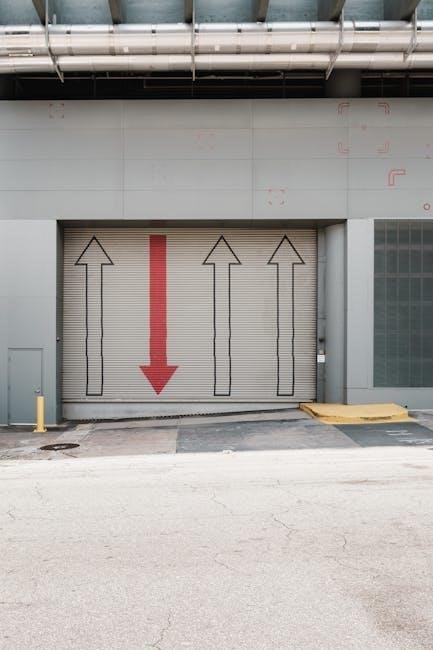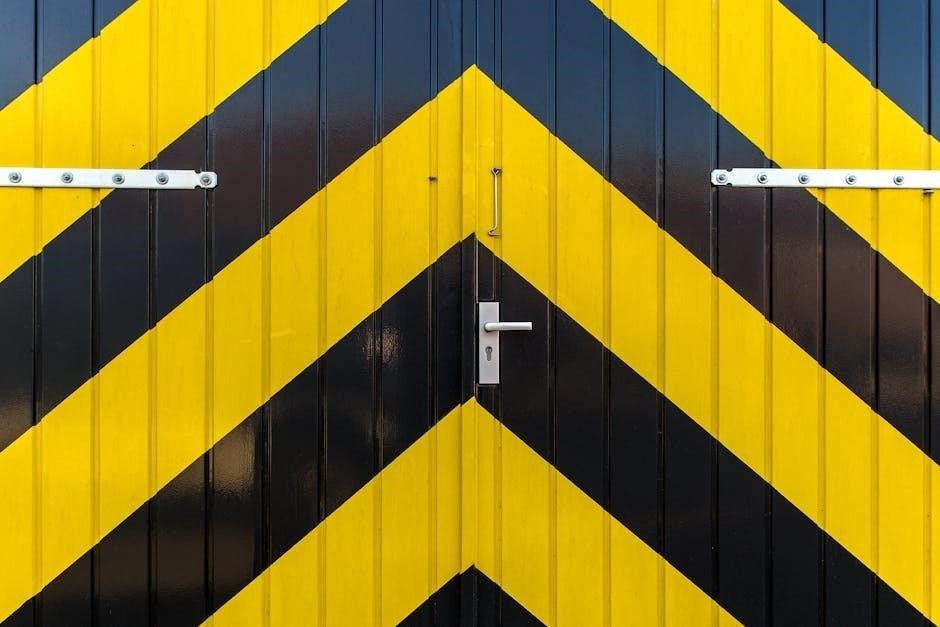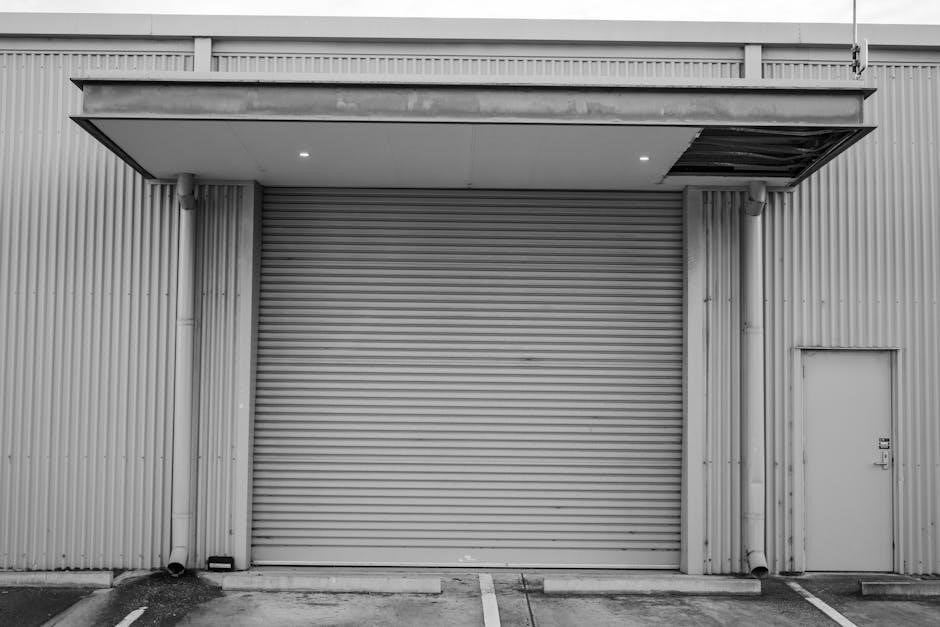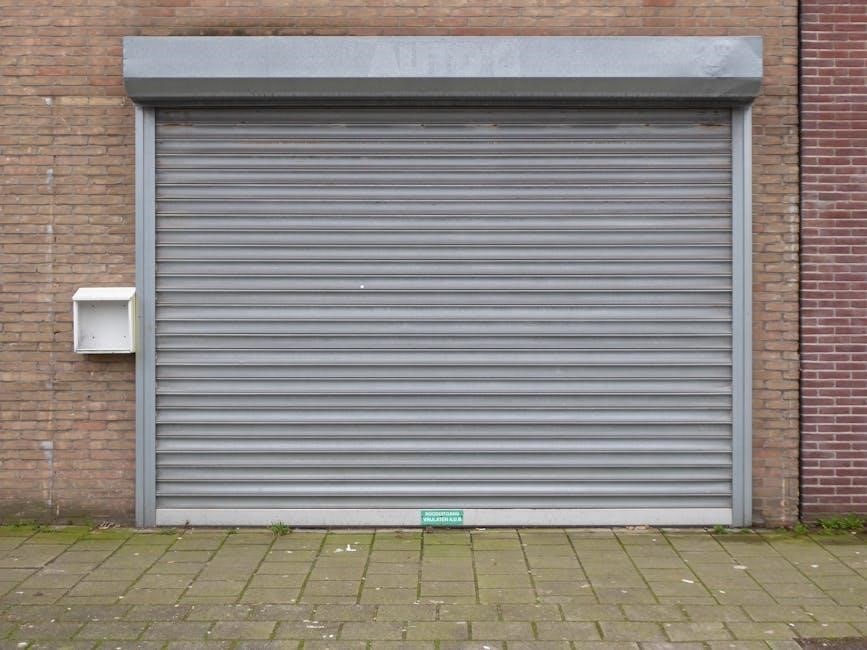Garage door troubleshooting is essential for maintaining functionality and safety. This guide empowers homeowners to identify and address common issues, from noisy operation to misaligned tracks, using DIY solutions. Regular maintenance and simple fixes can prevent costly repairs. Learn to diagnose problems, perform safe repairs, and understand when professional intervention is necessary to ensure your garage door operates smoothly and securely.

Common Garage Door Issues
Garage doors often face issues like improper closing, noise during operation, or misalignment. These problems can stem from worn-out rollers, broken springs, or debris in tracks. Regular lubrication and inspections can prevent many of these issues. Addressing them early ensures safety and avoids costly repairs. Simple DIY fixes often resolve these common problems effectively.
2.1. Door Does Not Close Properly
If your garage door fails to close properly, start by inspecting the safety sensors. Ensure they are clean, properly aligned, and free from obstructions. Misaligned sensors can prevent the door from closing completely. Next, check the limit switch, which controls the door’s closing point. Adjusting this switch may resolve the issue. Additionally, examine the tracks for debris or misalignment and clean or straighten them as needed. Lubricate rollers if they appear worn or rusty. Finally, inspect the weatherstripping for damage and replace it if necessary. Addressing these common issues can restore proper door function.

2.2. Noisy Garage Door Operation
A noisy garage door can be both annoying and a sign of underlying issues. Addressing this problem is crucial for maintaining smooth operation and preventing further damage. Common causes of noise include worn-out rollers, loose hardware, or insufficient lubrication. To resolve this, start by lubricating all moving parts, such as hinges, rollers, and tracks, using a silicone-based lubricant. This reduces friction and quiets operation.

Next, inspect the rollers for wear and tear. If they are damaged or rusted, consider replacing them with nylon or steel rollers, which are quieter and more durable. Additionally, check the hardware, such as bolts and screws, and tighten any loose components. Misaligned tracks can also contribute to noise, so ensure they are properly aligned and secure.

If the noise persists, it may indicate a more serious issue, such as damaged springs or faulty opener components. In such cases, it’s best to consult a professional to avoid safety risks. Regular maintenance, including lubrication and inspections, can prevent noisy operation and extend the life of your garage door. By addressing these common causes, you can restore a peaceful and efficient garage door function.

2.3. Garage Door Off-Track
A garage door that comes off its tracks can be a significant issue, posing safety risks and disrupting functionality. This problem often occurs due to accidental damage, such as hitting the door with a vehicle, or from misalignment over time. If left unaddressed, it can lead to further damage to the door, tracks, or surrounding structure.
To diagnose the issue, inspect the tracks for bends or obstructions. If the door is partially off-track, stop using it immediately to prevent worsening the problem. A common solution is to realign the tracks and ensure they are securely fastened. Use a rubber mallet to gently tap the tracks back into place, and tighten any loose bolts or screws.
Additionally, check for debris or obstructions in the tracks, such as dirt or ice, which may prevent the rollers from moving smoothly. Clearing these blockages can often resolve the issue. Lubricating the rollers and tracks with a silicone-based lubricant can also improve the door’s movement and prevent future misalignment.
However, if the tracks are severely bent or the door is completely off-track, it’s best to call a professional. Attempting to force the door back onto the tracks can cause further damage or safety hazards. Regular maintenance, such as inspecting and aligning the tracks, can help prevent this issue from recurring.
Addressing an off-track garage door promptly ensures safety and extends the lifespan of your door and its components. Always prioritize caution and seek professional assistance if the problem seems too complex to handle on your own.

2.4. Broken or Worn-Out Rollers

Broken or worn-out rollers are a common issue that can disrupt the smooth operation of your garage door. Rollers, which are attached to the door and move along the tracks, play a crucial role in the door’s functionality. Over time, these rollers can become worn, rusted, or even break, leading to noisy operation, slow movement, or the door getting stuck.
To diagnose this problem, inspect the rollers for visible signs of wear, such as cracks, rust, or missing parts. If a roller is broken or severely worn, it may cause the door to jerk or stop moving altogether. In some cases, the door may even come off the tracks if the rollers fail to guide it properly.
For repair, start by cleaning the rollers to remove dirt or debris that may be contributing to the issue. Apply a silicone-based lubricant to reduce friction and improve movement. If the rollers are damaged beyond repair, they will need to be replaced. While some rollers can be removed and replaced easily, others may require professional assistance, especially if they are attached with rivets or other secure fasteners.
When replacing rollers, ensure they are compatible with your garage door’s make and model. Improperly sized rollers can lead to further issues. Additionally, consider upgrading to nylon or steel rollers for better durability and smoother operation. Regular maintenance, such as lubricating the rollers and inspecting for wear, can help prevent this problem from recurring.
Addressing broken or worn-out rollers promptly is essential to maintain the efficiency and safety of your garage door. If the issue persists after DIY repairs, consult a professional to ensure the problem is resolved correctly and safely.

DIY Garage Door Repair Solutions
DIY garage door repair solutions can be an effective and cost-saving way to address common issues. With the right tools and knowledge, homeowners can tackle problems like noisy operation, misaligned tracks, and worn-out rollers. Start by gathering essential tools, such as a screwdriver, wrench, pliers, and a silicone-based lubricant. Lubricating moving parts like hinges, rollers, and tracks is a simple yet effective fix to reduce noise and friction.
For issues like a door that doesn’t close properly, inspect and clean the safety sensors. Ensure they are aligned and free from debris. If the problem persists, adjust the limit switch on the opener. Noisy operation can often be resolved by tightening loose hardware or replacing worn-out rollers. When replacing rollers, ensure they are compatible with your door’s make and model.
For misaligned tracks, gently tap them back into place using a rubber mallet and tighten the bolts. If the door is off-track, carefully lift it back into position and secure it. Regular maintenance, such as inspecting cables and springs, can help prevent major issues. However, if you encounter broken springs or severe damage, it’s best to call a professional to avoid safety risks.
Remember to always disconnect the power to the garage door opener before starting any repair. Safety should be your top priority. By following these DIY solutions, you can restore your garage door to optimal functionality and extend its lifespan. For more complex problems, consult a professional to ensure the repairs are done safely and effectively.

